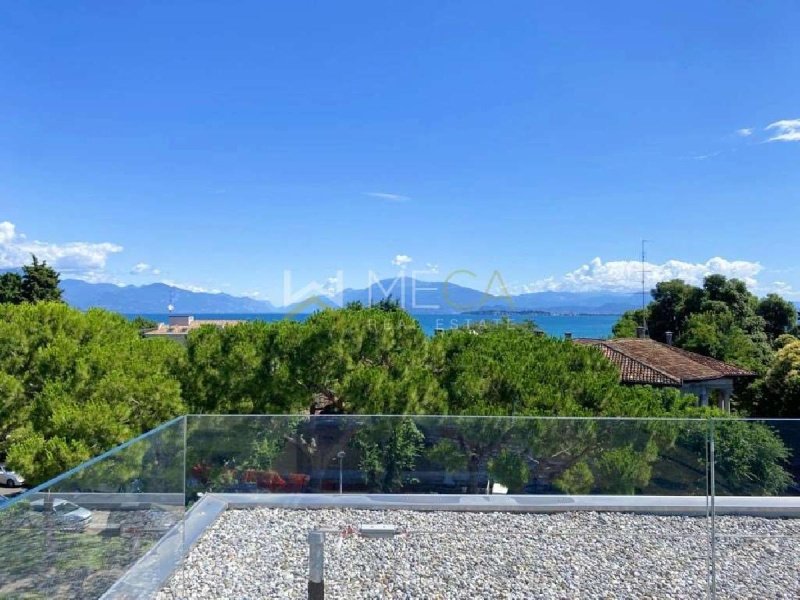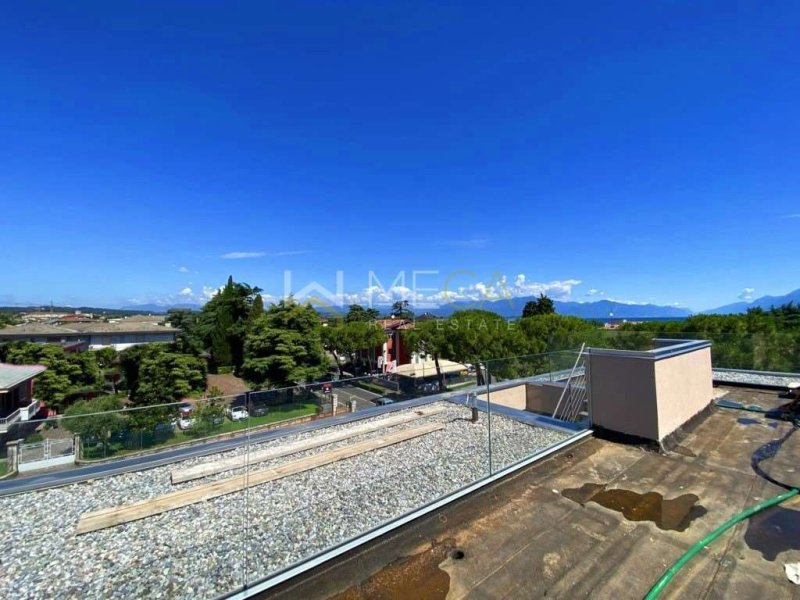Desenzano, centre, new penthouse being finished with excellent lake view from the roof terrace, set in an elegant context with swimming pool.
The attic is located on the second and last floor, served by a lift that connects to the garage area.
Located in the center of Desenzano, a few steps from the lake, the beach and all public and commercial services.
The attic consists of a very bright living area thanks to large windows, an open kitchen, a day bathroom, two double bedrooms and a further very spacious bathroom.
From the living area you have access to the terrace of approximately 50 sqm which can be walked on, via a spiral staircase you reach the solarium of approximately 100 sqm from which you can enjoy a wonderful lake view.
Excellent quality of finishes and construction.
Photovoltaic system, heat pump, underfloor heating, air conditioning, mechanical ventilation system, energy efficiency at the highest levels.
The attic has a quadruple garage of over 55 sqm, reachable by lift.
Lake Garda
Lake Garda or Benaco is the largest Italian lake, with a surface area of approximately 370 km² (third in depth after Como and Maggiore). Hinge between three regions, Lombardy (province of Brescia), Veneto (province of Verona), Trentino-Alto Adige (province of Trento), it is located parallel to the Adige, from which it is divided by the Monte Baldo massif. To the north it appears narrow like a funnel while to the south it widens, surrounded by moraine hills which make the landscape gentler. The lake is an important tourist destination and is visited by millions of people every year. In Roman times the lake was known as Benacus and was venerated by some as the god Benacus, the very personification of the lake, sometimes associated with the cult of the god Neptune. Today it is better known as Lake Garda, a toponym attested since the Middle Ages and of Germanic origin, deriving from that of the town of the same name on the Veronese side of the lake, which, together with another famous location on the lake, Gardone Riviera, and other less known, such as Gàrdola, Gardoncino, Gardoni, Guàrdola and Le Garde, testifies to the Germanic presence that goes from the 6th to the 8th century, in particular the Lombard one. The toponym Garda, with which the lake was already called in some documents from the 8th century, is the evolution of the Germanic word warda, meaning "place of guard" or "place of observation". The classic toponym of the lake, namely Bencus lacus (Benaco), is almost certainly of Celtic origin, therefore preceding Roman rule, and should derive from bennacus, comparable with the Irish bennach, and would mean "horned", or with many promontories. The translation "horned" is also interpreted in reference to the Sirmione peninsula. The Latin voice of Benaco is attested as Bencus, -i and therefore presupposes a plain accent (Benàco): the Italian version of the tonic accent remains faithful to the Latin accent, therefore it must be pronounced with the accent on the "a".
自动翻译所用的语言
Desenzano, centro, nuovo attico in fase di finitura con ottima vista lago dalla terrazza sul tetto, inserito in un contesto elegante con piscina.
L'attico si trova al secondo e ultimo piano, servito da ascensore che collega alla zona garage.
Posizionato nel pieno centro di Desenzano, a pochi passi dal lago, dalla spiaggia e da tutti i servizi pubblici e commerciali.
L'attico è composto da zona giorno molto luminosa grazie ai serramenti grandi, cucina a vista, bagno giorno, due camere matrimoniali e ulteriore bagno molto spazioso.
Dalla zona giorno si ha accesso alla terrazza di circa 50 mq calpestabili, tramite scala a chiocciola si raggiunge il solarium di circa 100 mq dalla quale si gode di una stupenda vista lago.
Ottima qualità delle finiture e della costruzione.
Impianto fotovoltaico, pompa di calore, riscaldamento a pavimento, aria condizionata, ventilazione meccanica controllata, efficienza energetica ai massimi livelli.
L'attico ha come pertinenza un garage quadruplo di oltre 55 mq, raggiungibile tramite ascensore.
Il lago di Garda
Il lago di Garda o Benaco è il maggiore lago italiano, con una superficie di circa 370 km² (terzo per profondità dopo Como e Maggiore). Cerniera fra tre regioni, Lombardia (provincia di Brescia), Veneto (provincia di Verona), Trentino-Alto Adige (provincia di Trento), è posto in parallelo all'Adige, da cui è diviso dal massiccio del monte Baldo. A settentrione si presenta stretto a imbuto mentre a meridione si allarga, circondato da colline moreniche che rendono più dolce il paesaggio. Il lago è un'importante meta turistica ed è visitato ogni anno da milioni di persone. In epoca romana il lago era conosciuto come Benacus e da alcuni era venerato come dio Benacus, personificazione stessa del lago, talvolta associata al culto del dio Nettuno. Oggi è meglio noto come lago di Garda, toponimo attestato fin dal Medioevo e di origine germanica, derivante da quello dell'omonima cittadina sulla sponda veronese del lago, la quale, insieme a un'altra località celebre del lago, Gardone Riviera, e altre meno conosciute, come Gàrdola, Gardoncino, Gardoni, Guàrdola e Le Garde, testimonia la presenza germanica che va dal VI all'VIII secolo, in particolare quella longobarda. Il toponimo Garda, con il quale è chiamato il lago già in alcuni documenti dell'VIII secolo, è l'evoluzione della voce germanica warda, ovvero luogo di guardia o luogo di osservazione. Il toponimo classico del lago, ovvero Bencus lacus (Benaco), è quasi sicuramente di origine celtica, precedente quindi al dominio romano, e dovrebbe derivare da bennacus, confrontabile con l'irlandese bennach, e significherebbe cornuto, ovvero dai molti promontori. La traduzione cornuto viene anche interpretata in riferimento alla penisola di Sirmione. La voce latina di Benaco è attestata come Bencus, -i e presuppone quindi un accento piano (Benàco): la versione italiana dell'accento tonico rimane fedele all'accentazione latina, quindi va pronunciato con l'accento sulla a.
CLASSE ENERGETICA:
Desenzano, Zentrum, neues Penthouse in Fertigstellung mit herrlichem Seeblick von der Dachterrasse, in elegantem Kontext mit Swimmingpool.
Das Dachgeschoss befindet sich im zweiten und letzten Stock und ist über einen Aufzug erreichbar, der mit dem Garagenbereich verbunden ist.
Gelegen im Zentrum von Desenzano, nur wenige Schritte vom See, dem Strand und allen öffentlichen und kommerziellen Dienstleistungen entfernt.
Das Dachgeschoss besteht aus einem dank großer Fenster sehr hellen Wohnbereich, einer offenen Küche, einem Tagesbad, zwei Doppelschlafzimmern und einem weiteren sehr geräumigen Badezimmer.
Vom Wohnbereich aus haben Sie Zugang zur begehbaren Terrasse von ca. 50 qm, ber eine Wendeltreppe erreichen Sie das Solarium von ca. 100 qm, von dem aus Sie einen herrlichen Seeblick genießen können.
Hervorragende Qualität der Oberflächen und der Konstruktion.
Photovoltaikanlage, Wärmepumpe, Fußbodenheizung, Klimaanlage, mechanisches Lüftungssystem, Energieeffizienz auf höchstem Niveau.
Das Dachgeschoss verfügt über eine über 55 qm große Vierfachgarage, die mit dem Aufzug erreichbar ist.
Gardasee
Der Gardasee oder Benacosee ist mit einer Fläche von etwa 370 km² der größte See Italiens (der drittgrößte nach Como und Maggiore). Er ist Scharnier zwischen drei Regionen, Lombardei (Provinz Brescia), Venetien (Provinz Verona) und Trentino-Südtirol (Provinz Trient) und liegt parallel zur Etsch, von der er durch das Monte-Baldo-Massiv getrennt ist. Im Norden erscheint er schmal wie ein Trichter, während er sich im Süden weitet und von Moränenhügeln umgeben ist, die die Landschaft sanfter machen. Der See ist ein wichtiges Touristenziel und wird jedes Jahr von Millionen von Menschen besucht. In der Römerzeit war der See als Benacus bekannt und wurde von manchen als der Gott Benacus verehrt, die Personifizierung des Sees selbst, die manchmal mit dem Kult des Gottes Neptun in Verbindung gebracht wird. Heute ist er besser bekannt als Gardasee, ein seit dem Mittelalter bezeugter Ortsname germanischen Ursprungs, der sich von dem der gleichnamigen Stadt auf der veronesischen Seite des Sees ableitet, die zusammen mit einem anderen berühmten Ort am See, Gardone Riviera, und anderen weniger bekannten Orten wie Gàrdola, Gardoncino, Gardoni, Guàrdola und Le Garde von der germanischen Präsenz vom 6. bis zum 8. Jahrhundert zeugt, insbesondere von der lombardischen. Der Ortsname Garda, mit dem der See bereits in einigen Dokumenten aus dem 8. Jahrhundert bezeichnet wurde, ist die Weiterentwicklung des germanischen Wortes warda, was Wachort oder Beobachtungsort bedeutet. Der klassische Ortsname des Sees nämlich Bencus lacus (Benaco), ist mit ziemlicher Sicherheit keltischen Ursprungs und stammt daher aus der Zeit vor der römischen Herrschaft. Er sollte von bennacus abgeleitet sein, vergleichbar mit dem irischen bennach, und würde gehörnt oder mit vielen Vorgebirgen bedeuten. Die Übersetzung gehörnt wird auch in Bezug auf die Halbinsel Sirmione interpretiert. Die lateinische Aussprache von Benaco ist als Bencus, -i belegt und setzt daher einen einfachen Akzent (Benàco) voraus: Die italienische Version des Tonika-Akzents bleibt dem lateinischen Akzent treu, daher muss er mit der Betonung auf dem a ausgesprochen werden.


